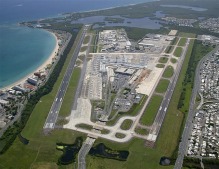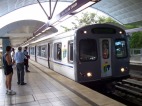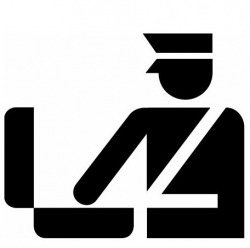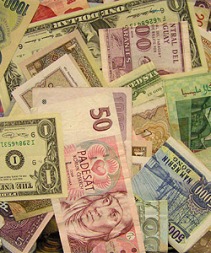Travel Information
Getting here...

Luis Muñoz Marín International Airport in San Juan (SJU) is the island's main airport and is most likely the cheapest to fly into. Located in the area known as Isla Verde, the airport was, for many decades, known as Isla Verde International Airport, until 1985, when then Governor Rafael Hernandez Colon decided to name it after Luis Munoz Marin, Puerto Rico's first democratically elected governor.
There are also regional airports: Rafael Hernandez International Airport in Aguadilla (BQN), Fajardo Airport in Fajardo (FAJ), Eugenio Maria de Hostos Airport in Mayagüez (MAZ), Humacao Airport in Humacao (HUC), and Mercedita Airport in Ponce (PSE). Ponce's airport is located two miles (3.2km) east of town. Flying time from San Juan is half an hour.
There are also regional airports: Rafael Hernandez International Airport in Aguadilla (BQN), Fajardo Airport in Fajardo (FAJ), Eugenio Maria de Hostos Airport in Mayagüez (MAZ), Humacao Airport in Humacao (HUC), and Mercedita Airport in Ponce (PSE). Ponce's airport is located two miles (3.2km) east of town. Flying time from San Juan is half an hour.
Getting around...

In Puerto Rico, it is relatively easy for visitors to get around and along with help from the OC Logistics, seeing the Island will not be difficult. There are taxis, car rentals, buses, and public transportation available throughout the country.Driving is on the right-hand side of the road. All the same rules as any part of the United States, except that the signs are in Spanish, the distance markers in kilometers and the gas sold in liters. All that is required to drive a car in Puerto Rico is a valid Country or International Driver's License.
Renting a Car
To rent a car, you must be at least 21 years of age and hold a valid Country or International Driver's License. Agencies are located around the island. Includes: AAA, Afro, Avis, Budget, Charlie, Discount, Hertz, L & M, Leaseway, National, Popular Leasing, Target, Thrifty, and Vias. Rates and availability can be found at any of the websites of the aforementioned car rental companies.
Buses
The Metropolitan Bus Authority (or AMA, its Spanish acronym) operates in the San Juan Metropolitan area. Stops are marked by magenta, orange and white signs which read "Parada." Buses run between certain hours, usually until 9:00 p.m. For routes and terminal schedule information, call (787) 767-7979. The Metro I, II, & III Buses cost $.50 per fare and all others cost $.75 per fare (exact change required).
Public transportation between cities is conducted in privately owned buses or mini-vans, called "guaguas". The "guaguas" or "carros publicos" usually stop in each town's main plaza. In addition to public transportation some cities provide "linéas," which are private taxis you share with three to five other passengers. There are more than 20 companies, each usually specializing in a certain region. Most will arrange door-to-door service.
Taxis
Taxis in Puerto Rico are generally expensive. The Tourism Taxi Program, recently instituted by the Puerto Rico Tourism Company, has simplified the fare structure between the airport, piers and several major tourism zones in the San Juan area. Charge set rates as follows (effective from November 17, 2005):
Taxi Rates
- Minimum charge - $3.00
- Initial charge - $1.00 x 1/13 mile
- Charge - $0.10 waiting time (every 45 seconds)
- Each piece of luggage (excluding hand pieces) - $0.50
- Extra piece of luggage (after three pieces) - $1.00
- Reservation of unit - $5.00
- Hourly rental charge - $20.00
- Night (10pm to 6am) over the meter charge - $1.00
Train
The Tren Urbano (urban train) is a 10.7 mile (17.2 km) metropolitan rapid-transit system which links the central business district to residential and employment areas in San Juan, Bayamón, and Guaynabo. Currently, the Tren Urbano is composed of 16 stations, ten of which are elevated, four at grade or in open cuttings, and two underground.The train runs everyday with from 5:30am to 11:30pm. The one way rate is $1.50, students. The fare includes a one-way transfer to ride the bus. For information call: 1-866-900-1ATI (1284).
Other Useful Travel Information
Renting a Car
To rent a car, you must be at least 21 years of age and hold a valid Country or International Driver's License. Agencies are located around the island. Includes: AAA, Afro, Avis, Budget, Charlie, Discount, Hertz, L & M, Leaseway, National, Popular Leasing, Target, Thrifty, and Vias. Rates and availability can be found at any of the websites of the aforementioned car rental companies.
Buses
The Metropolitan Bus Authority (or AMA, its Spanish acronym) operates in the San Juan Metropolitan area. Stops are marked by magenta, orange and white signs which read "Parada." Buses run between certain hours, usually until 9:00 p.m. For routes and terminal schedule information, call (787) 767-7979. The Metro I, II, & III Buses cost $.50 per fare and all others cost $.75 per fare (exact change required).
Public transportation between cities is conducted in privately owned buses or mini-vans, called "guaguas". The "guaguas" or "carros publicos" usually stop in each town's main plaza. In addition to public transportation some cities provide "linéas," which are private taxis you share with three to five other passengers. There are more than 20 companies, each usually specializing in a certain region. Most will arrange door-to-door service.
Taxis
Taxis in Puerto Rico are generally expensive. The Tourism Taxi Program, recently instituted by the Puerto Rico Tourism Company, has simplified the fare structure between the airport, piers and several major tourism zones in the San Juan area. Charge set rates as follows (effective from November 17, 2005):
- Zone 1 -Luis Muñoz Marín International Airport
- Zone 2 - Isla Verde ($10)
- Zone 3 - Condado, Ocean Park and Miramar ($15)
- Zone 4 - Old San Juan, Piers in Old San Juan, Puerta de Tierra and Miramar ($19)
- Zone 5 - Conventions Center and Luis Rivas Dominichi Airport in Isla Grande ($15)
Taxi Rates
- Minimum charge - $3.00
- Initial charge - $1.00 x 1/13 mile
- Charge - $0.10 waiting time (every 45 seconds)
- Each piece of luggage (excluding hand pieces) - $0.50
- Extra piece of luggage (after three pieces) - $1.00
- Reservation of unit - $5.00
- Hourly rental charge - $20.00
- Night (10pm to 6am) over the meter charge - $1.00
Train
The Tren Urbano (urban train) is a 10.7 mile (17.2 km) metropolitan rapid-transit system which links the central business district to residential and employment areas in San Juan, Bayamón, and Guaynabo. Currently, the Tren Urbano is composed of 16 stations, ten of which are elevated, four at grade or in open cuttings, and two underground.The train runs everyday with from 5:30am to 11:30pm. The one way rate is $1.50, students. The fare includes a one-way transfer to ride the bus. For information call: 1-866-900-1ATI (1284).
Other Useful Travel Information
- Driving - Traffic proceeds on the right. Signs are in Spanish, distance markers is posted in kilometers and the gas is sold in liters. Driver's License Valid resident country or international driver's license required.
- Fuel Stations - There are fuel stations throughout Puerto Rico. Some open 24 hours a day and nearly all supply leaded and unleaded gasoline and diesel. Don't be surprised to find a lot of fuel stations providing both full and self service
- Speed Limits - Highways are 65mph/112kph. Two-lane roads are 55 mph/88kph. Built-up areas are 30 mph/48kph unless otherwise posted. Drinking and Driving The penalties for drinking alcohol and driving afterwards are severe and exactly the same for both residents and visitors (legal drinking age of 18).
- Seat Belts - It is mandatory to wear seat belts, including the rear seats - if fitted.
Customs & Immigration

For United States citizens, there is no customs/immigration process when arriving to the Island. Likewise, there are no limits on the amount of goods moving between Puerto Rico and the Mainland. Citizens must only have a valid government-issued ID upon entering the country.
However, citizens of other countries follow the same customs and immigration guidelines for entering the United States. Potential visitors must obtain a visa to enter the United States and Puerto Rico, even if it is a temporary stay. Please view the visa process page for further instructions.
Puerto Rico is represented by the United States, so in most countries you can find the US Embassy or Consulate to help in the visa process. A complete list can be found here: http://www.usembassy.gov/. If you have any questions regarding your visa, please contact Seth Peterson, OC Delegate Services [[email protected]].
However, citizens of other countries follow the same customs and immigration guidelines for entering the United States. Potential visitors must obtain a visa to enter the United States and Puerto Rico, even if it is a temporary stay. Please view the visa process page for further instructions.
Puerto Rico is represented by the United States, so in most countries you can find the US Embassy or Consulate to help in the visa process. A complete list can be found here: http://www.usembassy.gov/. If you have any questions regarding your visa, please contact Seth Peterson, OC Delegate Services [[email protected]].
Costs & Exchange Rates

An exchange rate calculator can be found here to estimate the most up to date exchange rate: http://www.xe.com/ucc/. Currency exchange can be done at the airport upon arrival, but other options are also available and offer better exchange rates:
Credit Cards
All major credit cards (Visa, Mastercard, American Express, etc...) are widely accepted on the Island. Below are numbers to call if you lost your card:
ATMs/Cash Withdrawal
Called "ATHs" in Puerto Rico, ATMs are a convenient way of obtaining cash from a bank account back home. Even many small-town banks in the middle of nowhere have ATMs. They are common in most shopping areas and are often available 24 hours a day.
There are various ATM networks, and most banks in Puerto Rico are affiliated with several. Exchange, Accel, Plus and Cirrus are the predominant networks. For a nominal service charge, you can withdraw cash from an ATM using a credit card or a debit card. Be aware of your bank's international withdrawal fees and regulations.
Relative Costs
Food
Tipping
On the island, tipping is in order in restaurants and better hotels. Taxi drivers, hairdressers and baggage carriers expect tips, and waiters and bartenders rely on tips for their livelihoods. Tip 5-10% unless the service is terrible, or about 10-20% if the service is great. Never tip in fast-food, take-out or buffet-style restaurants where you serve yourself. Baggage carriers in airports and hotels get $2 for the first bag and $1 for each additional bag. In hotels with daily housekeeping staff, leave a few dollars in the room when you check out – ask at the desk regarding the appropriate amount per day. In budget hotels, tips are not expected, but are always appreciated.
- Banco Popular, International Currency Exchange at any branch office (for branch office locater: www.bppr.com)
- Caribbean Foreign Exchange, 201B Tetuan, Old San Juan, (787) 722 - 8222
- Thomas Cook Foreign Exchange, SJU Airport, (787) 791 - 1960
- Other banks include: Doral Bank, Westernbank, Scotia Bank, and others.
Credit Cards
All major credit cards (Visa, Mastercard, American Express, etc...) are widely accepted on the Island. Below are numbers to call if you lost your card:
- American Express (800-528-4800)
- Diners Club (800-234-6377)
- Discover (800-347-2683)
- MasterCard (800-826-2181)
- Visa (800-336-8472)
ATMs/Cash Withdrawal
Called "ATHs" in Puerto Rico, ATMs are a convenient way of obtaining cash from a bank account back home. Even many small-town banks in the middle of nowhere have ATMs. They are common in most shopping areas and are often available 24 hours a day.
There are various ATM networks, and most banks in Puerto Rico are affiliated with several. Exchange, Accel, Plus and Cirrus are the predominant networks. For a nominal service charge, you can withdraw cash from an ATM using a credit card or a debit card. Be aware of your bank's international withdrawal fees and regulations.
Relative Costs
Food
- Budget - $5-12
- Moderate - $15-20
- High - $25+
- Budget - $65-85/night
- Moderate - $90-140/night
- High - $150-200+/night
- Beer - $1-3
- Soda - $.50-1.50
- Drink (alcoholic) - $2-6 (varies)
- Juices - $1.50-3
Tipping
On the island, tipping is in order in restaurants and better hotels. Taxi drivers, hairdressers and baggage carriers expect tips, and waiters and bartenders rely on tips for their livelihoods. Tip 5-10% unless the service is terrible, or about 10-20% if the service is great. Never tip in fast-food, take-out or buffet-style restaurants where you serve yourself. Baggage carriers in airports and hotels get $2 for the first bag and $1 for each additional bag. In hotels with daily housekeeping staff, leave a few dollars in the room when you check out – ask at the desk regarding the appropriate amount per day. In budget hotels, tips are not expected, but are always appreciated.

